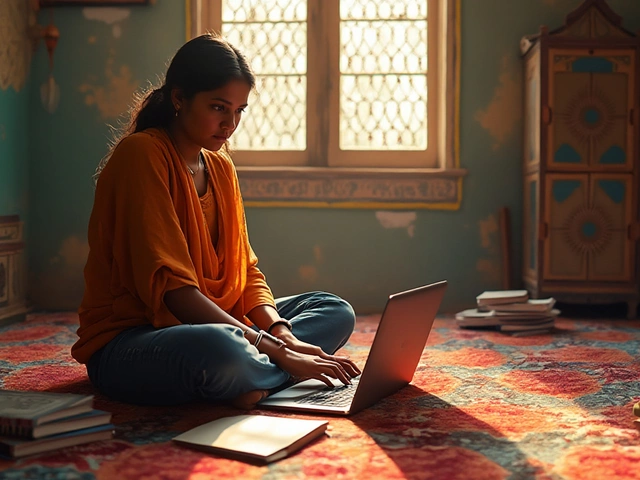Jun
24

- by Dhruv Ainsley
- 0 Comments
Picture this: a packed lecture hall, laptops glowing, caffeine-fueled students crunching numbers, and stress hanging thicker than humidity in Mumbai’s monsoon. If that scene gives you goosebumps, you’re not alone—talk about toughest MBA programs sparks fierce debates in coffee shops, office Slack channels, and MBA forums everywhere. There’s an unspoken prestige to surviving the hardest: but what actually qualifies an MBA as ruthless? Is it the killer coursework, brutal grading, or soul-sapping culture? Let’s dig in and settle the score, minus the B-school myths and marketing fluff you find on glossy brochures.
What Actually Makes an MBA Program "Tough"?
Anyone who’s ever survived a group project knows that ‘tough’ means more than complicated math equations. Sure, academic rigor matters—at places like MIT Sloan, Chicago Booth, and INSEAD, you’ll run headfirst into monster quant classes, hours-long case studies, and enough late-night teamwork to make even seasoned professionals crave nap time. But there’s more hiding beneath the surface: admissions selectivity, the peer group’s intensity, an unforgiving grading curve, and the extracurricular hustle can transform even supposedly “laid-back” schools into pressure cookers.
Look at Harvard Business School’s famous cold-calling. There, every student is expected to lead discussions, and if you stumble, you’ll remember the feeling forever. It’s hardly the only stressor: Wharton’s legendary finance core and INSEAD’s 10-month, all-gas-no-brakes pace both have reputations for churning out sleepless, overcaffeinated zombies. The classroom challenge piles on: MIT’s Analytical Methods, Booth’s “Turbulent Markets,” and Stanford’s Interpersonal Dynamics (‘Touchy Feely’) are each rigorous in their own flavors, blending theory, casework, and unrelenting presentations. Case method heavy? Expect 500 pages of reading per week.
But it isn’t just about academics. MBAs pack in recruiting battles, endless networking events, club competitions, investment pitch nights, and startup hackathons. People who expected ‘party school’ vibes often get whiplash. At top-tier Indian B-schools (like IIM Ahmedabad), you’ll deal with relentless schedules and savage grade deflation—think 2-3 hours of sleep, every night for weeks. Startups and consulting interviews can raise the anxiety to dizzying heights: 97% of HBS students participate in recruiting, and just getting a slot at McKinsey or Blackstone sometimes feels harder than getting into the programs themselves. If you thrive under relentless deadlines, fine—but ‘tough’ can mean burnout for the rest.
Culture matters, too. Ask graduates what made their MBA “hellish” and you’ll hear about cohort competitiveness, FOMO-driven lives, lack of downtime, and the invisible social ranking. At INSEAD, regular 80-hour study weeks are the norm thanks to its compressed format. Stanford’s famed ‘Work-Life Balance’ is just an urban legend for students juggling Silicon Valley internships and marathon entrepreneurship classes.
Bottom line: ‘tough’ isn’t one-size-fits-all. What fries one student’s brain (corporate finance, say) leaves others unfazed, while cultural stress or peer comparison chews up the rest. The famous “lipstick index” for MBAs? Track caffeine sales near campuses during finals week.
Notorious Reputations: The MBA Heavyweights Breakdown
So, which MBAs make the cut as the hardest in the world? Here’s a straight-talking look at the heavyweights:
- INSEAD: Known as “The Business School for the World,” this one-year blender of an MBA program squeezes two years’ worth of learning into 10 months. Five periods, no break, classes on weekends, plus job hunting. Students call it a pressure cooker—and by the third period, many haven’t slept a full night in weeks. Its academic rigor, multicultural peer group (over 90 nationalities), and constant networking combine for true mental mayhem.
- IIM Ahmedabad (India): Possibly Asia’s toughest. Students nickname its Academic Block “The Womb”—you enter, barely sleep, and emerge reborn (hopefully). The triple whammy of grade deflation, marathon case competitions, and 6 am quizzes keeps even top performers on edge. Peer pressure runs sky-high: an actual meme states, “If you sleep, you fail.”
- Wharton (UPenn): Famous for its hardcore analytical curriculum and the most rigorous core in finance anywhere. Classes like Corporate Valuation and Advanced Investments are notorious. A 2023 survey showed Wharton students pull the most all-nighters (16 per semester, on average) among the US M7 (Magnificent 7) schools. The grade non-disclosure policy? Don’t bet on it to lower stress.
- Harvard Business School (HBS): The iconic Case Method keeps students on their toes—if cold-called, you’d better shine, or risk social and academic fallout. The relentless pace of 12 cases a week, plus mandatory participation, means you’re always ‘on stage.’ It’s not a place for coasting.
- MIT Sloan: Quantitative to a fault, with subjects like Data, Models, and Decisions that eat up whole weekends. MIT’s recruiting scene is also brutally competitive, and the “Sloan Interview Day” is infamous for its pressure and speed. Plus, the tech-focused peer group means nobody’s slouching.
- Chicago Booth: Known for the “Analytical Rigour” badge, Booth’s flexible curriculum can become a minefield if you stack all the difficult classes together. Students love the intellectual sparring—until finals, when the pressure goes up to eleven.
Of course, there are other famously hard programs: CEIBS in China, LBS in the UK, and the consulting-heavy curriculum at Kellogg. But these six get singled out repeatedly by alumni, recruiters, and MBA rankings for record dropout rates, marathon schedules, and forensic-level scrutiny of every mistake. Survival sometimes hinges more on time management than raw intelligence.
Here’s a taste of how these MBAs stack up in some tangible categories:
| MBA Program | Typical Weekly Hours | Program Length (Months) | Dropout Rate (%) | Class Size |
|---|---|---|---|---|
| INSEAD | 75-85 | 10 | 8 | 1000 |
| IIM Ahmedabad | 70-80 | 24 | 11 | 400 |
| Wharton | 60-75 | 21 | 6 | 860 |
| HBS | 55-70 | 21 | 5 | 930 |
| MIT Sloan | 60-75 | 21 | 6 | 400 |
| Chicago Booth | 55-70 | 21 | 5 | 620 |
Notice the common thread? The shortest MBAs with the most weekly hours and the highest dropout rates earn the ‘toughest’ label every time. Size matters, too: bigger classes mean you can get lost—or find fiercely competitive cliques.

Tips for Surviving the Most Challenging MBAs
You don’t need to be a genius—just crafty, resilient, and a little ruthless about the sleep schedule (or, in my case, learn to make three-minute noodles on autopilot). Here’s what actually works in the trenches:
- Pick Your Battles Early: You can’t ace everything. MBAs are buffet cruelty: more clubs, events, and cases than anyone could handle. Winners learn to say “no” without guilt or FOMO.
- Master the Calendar: Living by Google Calendar (or Notion, if you’re fancy) is non-negotiable. Block time for workouts, laundry, even power naps. Otherwise, you’ll drown.
- Team Up, Don’t Go Solo: The smartest move isn’t knowing everything yourself. It’s building a ‘crash team’—three or four classmates who balance your skills. MBA misery loves company, and peer learning is the only way to keep up.
- Beware the Club Trap: Students sign up for 15 clubs, end up burned out and friendless. Pick what truly matters for your career—not what looks best on LinkedIn.
- Insider Recruiting Secrets: Prep for networking stress by reaching out to 2nd-years and alumni—don’t rely on mass resumes alone. And understand “fit” trumps grades in consulting, while investment banks still care about quant prowess.
- Protect Your Mental Health: Know the warning signs of burnout. Every elite business school now offers free therapy, meditation apps, and peer support—but making time for them is what distinguishes the survivors from sad stories.
- Sleep Trumps Netflix: Tempting as it is, doomscrolling hurts productivity much more than skipping a case summary. Smart students treat sleep as sacred—nothing good happens after midnight in B-school land.
- Reflect Sooner Rather Than Later: Take 30 minutes each week to check if you’re on track for your goal (be it consulting, a startup, or family life). Otherwise, it’s easy to join every rat race and end up nowhere.
Every year, a surprising number of students get caught in the "comparison trap." It’s easy to think everybody else is pulling all-nighters, getting the ‘dream offer’, and hitting the gym five times weekly. In reality, most are just hanging on for dear life. My buddy at Wharton once told me, “The imposter syndrome is real, but the support network is even more real—if you bother to use it.”
No matter how hard the program, there’s always someone more stressed out than you. That’s comforting in a weird way.
Comparing the Culture and Challenges Around the World
It’s tempting to put all tough MBAs in one basket, but location colors the flavor of misery in big ways. For example, European programs (like INSEAD, LBS, and HEC Paris) often compress learning into shorter formats, which means the same content as two-year American MBAs, but with half the breaks. The upside? They attract older, more experienced students—arguably making the cliff jump even steeper if you’ve been out of academics for a decade.
Asian MBAs—such as IIM Ahmedabad, CEIBS, or NUS—feature gigantic class sizes, stricter grading, and higher peer pressure. There’s a cultural angle too: in India, showing vulnerability is tough, so students are less likely to seek help, raising burnout risk. In China, the curriculum often stacks mandatory seminars and group projects on top of individual work, with long commutes to boot.
US elite programs have their own brand of toughness, blending endless extracurriculars and a networking “arms race.” While many offer flexible curriculums (Booth, Sloan), others enforce non-optional, sink-or-swim courses (HBS, Wharton, Kellogg’s Leadership Lab). The social scene can be overwhelming—think themed parties and club-led trips—but missing them can feel like career sabotage.
Family matters, too. More students now have kids or care for elderly parents while juggling coursework. Work-life balance is mostly aspirational. A friend at Sloan said she only saw her toddler awake on Sundays. I’ve seen classmates at INSEAD haul baby monitors to study sessions—when there’s no time for a break, you bring the life you already have right along with you.
The trend toward more international candidates has made languages an unexpected pain point. At INSEAD, for instance, you’re expected to speak three languages (minimum!) by graduation. At LBS and IMD, intercultural team clashes add firefighting duties: how to resolve a case when half your group wants consensus and the others want a decision—last week?
An interesting observation: in programs where students are older and busier, dropouts are slightly higher—not because they can’t hack it academically, but because outside priorities kick in hard. Single 25-year-olds cuddle up with casebooks, while 40-year-old execs sometimes just quit when the life-juggling becomes too much. European MBAs lead in this stat: IMD’s 12% dropout rate outpaces any US rival.
Despite all the hardship, there’s a twisted badge of honor in enduring these programs. At reunions, “which classes broke you?” stories get even more airtime than salary talk. If there’s one unifying thread across the countries, it’s this: your peers, for better or worse, make the pain memorable—sometimes even bearable.

What You Should Ask Yourself Before Applying
Maybe you’re drawn to challenge. Maybe it’s the career boost—or the party stories for decades to come. But before you pull the trigger, pause for a hot second. Here’s what matters most when choosing (or surviving) the toughest MBA out there:
- What’s your pain threshold? Love competitive spaces, endless challenge, and feedback? Or do you prefer breathing room for creativity? “Hard” isn’t universally good or bad—it needs to fit your style.
- What’s your support system? If you have family, kids, health needs, or side hustles, look for MBAs that value flexibility. Don’t be swayed by rankings alone. An extra year of part-time study could make a world of difference.
- What’s your endgame? The hardest program may not be the best if your goals are startup inbound, early career pivots, or balancing home with hustle. For some, intensive quant is non-negotiable; for others, leadership or global immersion matters more.
Statistically, about 8% of admits end up dropping or deferring from the world’s “hardest” MBAs. That’s not a failure—it’s a recalibration. The rest emerge either transformed, exhausted, or deliriously ready for a soft office chair and a regular sleep schedule. If you’re dreaming of a grueling, all-consuming challenge to reboot your career, you’ll find it—you just have to choose your flavor of pain.
Me? When my little girl Amaya asks why I have grey hair at 37, I’ll have a stack of war stories to blame—the right answer to “Which is the toughest MBA?” depends as much on who you are as where you study. And if you’re staying up all night trying to choose, well, you’re already practicing for the real thing.





